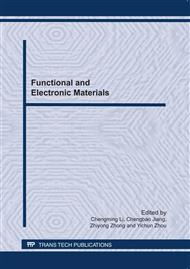p.327
p.333
p.339
p.343
p.348
p.354
p.359
p.366
p.370
Physical and Electrical Properties of Lead-Free (Bi0.5Na0.5)TiO3-(Na0.5K0.5)NbO3 Ceramics
Abstract:
Lead-free (1-x)(Bi0.5Na0.5)TiO3–x(Na0.5K0.5)NbO3 (x<0.1) ceramics have been prepared by the conventional mixed oxide process. X-ray diffraction analysis revealed that, during sintering, all of the (Na0.5K0.5)NbO3 diffuse into the lattice of (Bi0.5Na0.5)TiO3 to form a solid solution and the hexagonal phase with a perovskite structure. The samples with a low content of (Na0.5K0.5) NbO3 exhibit relatively good physical and electrical properties. For 0.96(Bi0.5Na0.5) TiO3–0.04 (Na0.5K0.5) NbO3 ceramics, the electromechanical coupling coefficients of the planar mode kp and the thickness mode kt reach 0.25 and 0.52, respectively, after sintering at 1100 °C for 5 h. The ratio of the thickness coupling coefficient to the planar coupling coefficient is 2.08. With suitable (Na0.5K0.5)NbO3 concentration and sintering conditions, a dense microstructure and good electrical properties are obtained. Our results show that 0.96(Bi0.5Na0.5)TiO3–0.04(Na0.5K0.5)NbO3 solid solution ceramics are promising lead-free ceramics for high-frequency electromechanical transducer applications.
Info:
Periodical:
Pages:
348-353
Citation:
Online since:
June 2011
Authors:
Keywords:
Price:
Сopyright:
© 2011 Trans Tech Publications Ltd. All Rights Reserved
Share:
Citation:


